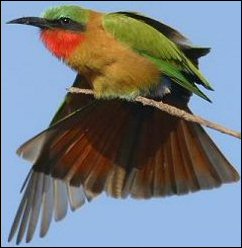Republic of South Sudan

Birding South Sudan
South Sudan is situated in northern Africa. It borders the countries of Central African Republic, Chad, Democratic Republic of the Congo, Ethiopia, Kenya and Uganda. It is dominated by the River Nile and its tributaries. The terrain is generally flat plains, broken by several mountain ranges; the highest mountain is Mount Kinyeti Imatong, near the border with Uganda.The amount of rainfall increases towards the south where there are swamps and rain forest. Sudan’s rainy season lasts for up to six months (June to November) in the south. The dry regions are plagued by sand storms, known as haboob, which can completely block out the sun. In the northern and western semi-desert areas, people rely on the scant rainfall for basic agriculture and many are nomadic, traveling with their herds of sheep and camels. Nearer the River Nile, there are well-irrigated farms growing cash crops.Rich mineral resources are available in South Sudan including: petroleum, natural gas, gold, silver, chromite, asbestos, manganese, gypsum, mica, zinc, iron, lead, uranium, copper, kaolin, cobalt, granite, nickel and tin.There is concern over soil erosion. Agricultural expansion, both public and private, has proceeded without conservation measures. The consequences have manifested themselves in the form of deforestation, soil desiccation, and the lowering of soil fertility and the water table.The nation’s wildlife is threatened by hunting. As of 2001, twenty-one mammal species and nine bird species are endangered, as well as two types of plants. Endangered species include: the waldrapp, northern white rhinoceros, tora hartebeest and the slender-horned gazelle. In May 2007, it was announced that hundreds of wild elephants had been located on a previously unknown, treeless island in the Sudd swampland region of southern Sudan. The exact location being kept secret to protect the animals from poachers.
-
Number of bird species: 1022
(Includes North Sudan too)
-
iGoTerra Checklist
iGoTerra ChecklistFatbirder Associate iGoTerra offers the most comprehensive and up to date birds lists on the web
-
Field Guide to Birds of East Africa Kenya, Tanzania, Uganda, Rwanda and Burundi
By Terry Stevenson, John Fanshawe, Brian E Small & John Gale | Christopher Helm | 2004 | Paperback | 640 pages, colour plates, colour distribution maps, colour & b/w maps | ISBN: 9780713673470 Buy this book from NHBS.com
-
African Bird Club
WebsiteThere is plenty to attract the keen birdwatcher to Sudan were it not for major concerns over safety. One can only hope that the situation improves sufficiently to allow greater travel in this country. Sudan is not a country where you will see the huge range of species on offer in East Africa but the Nile which flows through the capital Khartoum is a major migration corridor and birdwatching in this area will provide a good range of species and some surprises
-
IBAs
WebsiteSatellite ViewThe enormous range of latitudes supports portions of 6 biomes: Saharan-Sindian in the north; Sahel; much of the south is within Sudan-Guinea Savanna; Guinea-Congo Forests in the south-west; Somali-Masai in the south-east; the southern mountains lie within the Afrotropical Highlands biome. Inland wetlands dominated by the Sudd are significant for large numbers of waterbirds and some of Sudan -
NP Bandingilo
InformationSatellite ViewThe Bandingilo National Park, sometimes spelled Badingilo, is located in South Sudan's Equatoria region. The park covered the erstwhile states of Central Equatoria and Eastern Equatoria. It was established in 1992. Situated in a wooded area near the White Nile River, it is over 10,000 square kilometres (3,900 square miles) in size. It is home to the world's second-largest annual animal migration (largest is the Serengeti migration), involving multiple species of antelope including reedbuck, tiang, and white-eared kob, takes place in the park, which is also home to iconic African megafauna like the Nubian giraffe. -
NP Boma
InformationSatellite ViewBoma National Park is a protected area in eastern South Sudan near the Ethiopian border. It was established in 1986 and covers 22,800 km2 (8,800 sq mi) of grasslands and floodplains. It is also an important bird area: avifauna includes Ruppell's vulture and the black-chested snake eagle. The neighbouring Gambela National Park in Ethiopia protects similar species. -
NP Lantoto
InformationSatellite ViewLantoto National Park is a protected area in southwestern South Sudan on the border with the DRC. The park has an area of 760 km2 (290 sq mi) and is predominantly woodland, forest and open glades. -
NP Nimule
InformationSatellite ViewThe Nimule National Park is found in South Sudan. It was established in 1954, and extends over an area of 410 km². -
NP Shambe
InformationSatellite ViewThe Shambe National Park is found in South Sudan. It was established in 1985 and extends over an area of 620 km2 (240 square miles). -
NP Southern
InformationSatellite ViewA.B. Anderson, a former Assistant Game Warden, reported that in 1950 that the Southern National Park was spread over an area of 7,800 square miles (20,000 km2). It was drained by three rivers: the Sue River to the west, a well-defined channel that joined the Nile; the Gel River to the east; and the Ibba River in the centre of the park. The Gel and Ibba Rivers, after flowing through the park, formed a flood plain which made the habitat swampy.

